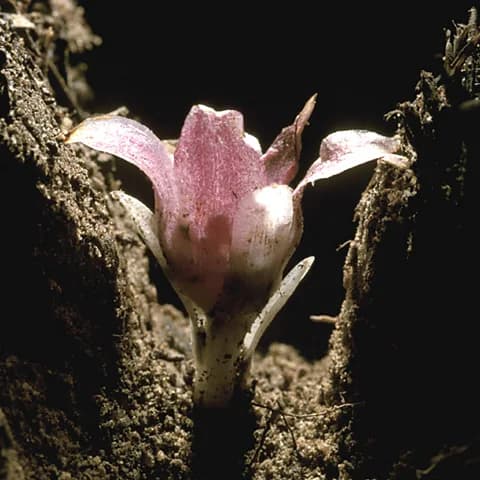Loading News Article...
We're loading the full news article for you. This includes the article content, images, author information, and related articles.
We're loading the full news article for you. This includes the article content, images, author information, and related articles.
A unique orchid species, Rhizanthella, living entirely underground and reliant on fungi, is critically endangered, prompting global conservation efforts with potential implications for Kenya's rich biodiversity.

Botanists worldwide are racing against time to save the extraordinary Rhizanthella orchid, a species that spends its entire life cycle hidden beneath the soil. This rare plant, which flowers underground and lacks leaves, sustains itself by drawing nutrients from a fungus that, in turn, connects with the roots of the broom bush (Melaleuca uncinata). Its precarious existence highlights the intricate dependencies within ecosystems and offers valuable lessons for biodiversity conservation in Kenya.
The Rhizanthella orchid first captivated international attention in 1928 when a farmer in Western Australia unearthed it. Despite its initial discovery, the orchid remains exceptionally difficult to locate, requiring meticulous searching in specific habitats and careful excavation to reveal its tiny, reddish blooms encased in creamy-pink bracts. These blooms are noted for their strong vanilla scent, suggesting pollination by subterranean insects such as termites or small flies.
There are five known species of Rhizanthella, all of which are considered among the rarest orchids globally. Their populations are critically low, rendering them highly vulnerable to extinction. Habitat loss and prolonged droughts, exacerbated by climate change, are identified as primary threats to their survival. While Rhizanthella is not native to Kenya, its plight underscores the broader challenges faced by unique plant species globally, including those in Kenya's diverse ecosystems.
In Kenya, similar conservation concerns exist for indigenous plant species, many of which are threatened by deforestation, agricultural expansion, and climate variability. The strategies employed to protect the Rhizanthella could inform approaches to safeguard Kenya's own endangered flora, particularly those with complex ecological requirements.
Dr. Kingsley Dixon, a botanist at the University of Western Australia, is leading urgent conservation efforts for the Rhizanthella orchid. His team is pioneering techniques to cultivate the orchid by growing the symbiotic fungus alongside the orchid seeds in a laboratory setting. These cultivated orchid-fungus complexes are then transferred to Melaleuca bushes grown in pots, mimicking their natural subterranean environment. This innovative approach offers a glimmer of hope for the species' long-term survival.
Such scientific interventions demonstrate the critical role of research and development in addressing biodiversity crises. Kenyan researchers and conservationists could explore similar symbiotic relationships and propagation techniques for local endangered species, fostering collaborations with international experts like Dr. Dixon.
The conservation of rare species like Rhizanthella necessitates robust policy frameworks and effective governance. In Kenya, the Wildlife Conservation and Management Act of 2013 provides a legal framework for protecting endangered species and their habitats. However, effective implementation requires sustained funding, public awareness, and inter-agency collaboration. The challenges faced by Rhizanthella highlight the need for proactive measures to protect lesser-known, yet ecologically vital, plant species.
Kenya's National Museums and various environmental organisations play a crucial role in documenting and conserving the country's botanical heritage. Learning from international efforts can strengthen local strategies, particularly in areas of habitat restoration and community engagement.
While significant progress has been made in understanding Rhizanthella, several aspects remain unknown. The precise mechanisms of its subterranean pollination, for instance, are still being investigated, with termites or tiny flies being hypothesised pollinators. The full extent of its genetic diversity across the five species also requires further research to inform comprehensive conservation strategies. There are no known major controversies surrounding its conservation, but the difficulty in locating and studying the orchid presents inherent challenges.
The ongoing research by Dr. Dixon and his team will be crucial in determining the long-term viability of laboratory-assisted propagation for Rhizanthella. Success in these efforts could provide a blueprint for conserving other rare and difficult-to-cultivate plant species globally. For Kenya, observing these developments can offer insights into advanced botanical conservation techniques applicable to its own unique and threatened flora.
Keep the conversation in one place—threads here stay linked to the story and in the forums.
Other hot threads
E-sports and Gaming Community in Kenya
Active 6 months ago
Popular Recreational Activities Across Counties
Active 6 months ago
The Role of Technology in Modern Agriculture (AgriTech)
Active 6 months ago
Investing in Youth Sports Development Programs
Active 6 months ago